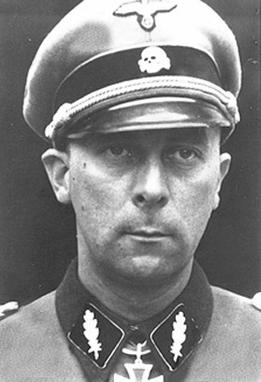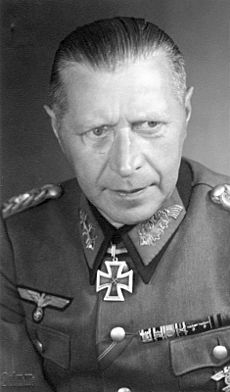Wilhelm Mohnke facts for kids
Quick facts for kids
Wilhelm Mohnke
|
|
|---|---|

Mohnke in 1944
|
|
| Born | 15 March 1911 Free City of Lübeck, German Empire |
| Died | 6 August 2001 (aged 90) Barsbüttel, Schleswig-Holstein, Germany |
| Allegiance | |
| Service/ |
|
| Years of service | 1931–45 |
| Rank | SS-Brigadeführer und Generalmajor der Waffen-SS |
| Service number | NSDAP #649,684 SS #15,541 |
| Commands held | SS Division Leibstandarte Kampfgruppe Mohnke |
| Battles/wars | World War II |
| Awards | Knight's Cross of the Iron Cross German Cross in Gold War Merit Cross |
Wilhelm Mohnke (born March 15, 1911 – died August 6, 2001) was an important German military leader during World War II. He was one of the first members of the SS-Staff Guard, a special unit formed in 1933. Mohnke became one of Adolf Hitler's last high-ranking generals. He joined the Nazi Party in September 1931.
Mohnke fought in many battles with the SS Division Leibstandarte, including those in France, Poland, and the Balkans. In 1943, he was put in charge of a regiment in the SS Division Hitlerjugend. He led this unit during the Battle for Caen and received a high award, the Knight's Cross of the Iron Cross, in July 1944. Later, in December 1944, Mohnke took command of his original division, the Leibstandarte, during the Battle of the Bulge.
During the final Battle of Berlin, Mohnke led a special fighting group called Kampfgruppe Mohnke. His job was to defend the main government area of Berlin, including the Reich Chancellery and the Reichstag. After the war, he was investigated for claims of mistreating prisoners during the war. However, Mohnke was never officially charged with any crimes. He spent 10 years held by the Soviet Union and passed away in 2001 at the age of 90.
Contents
Early Life and Joining the SS
Wilhelm Mohnke was born in Lübeck, Germany, on March 15, 1911. His father, also named Wilhelm, worked as a cabinetmaker. After his father died, Mohnke worked for a company that made glass and porcelain. He eventually became a manager there and also earned a degree in economics.
Mohnke joined the Nazi Party on September 1, 1931. Soon after, he became a member of the SS, which was a powerful organization within the Nazi Party. He started as a private (SS-Mann). When Adolf Hitler became the leader of Germany in 1933, the SS leadership in Berlin asked for the best soldiers from each SS group to join a special guard unit for Hitler. Mohnke was chosen for this unit in March 1933. He was assigned to the SS-Stabswache Berlin, which guarded the original government building. By August, Mohnke was one of the unit's company commanders.
World War II: A Time of Conflict
Mohnke took part in the fighting in Poland in September 1939. He was injured on September 7, 1939, and recovered in a hospital. For his injury, he received the Wound Badge. He also earned the Iron Cross, Second Class, in September 1939 and the Iron Cross, First Class, in November 1939.
In 1940, Mohnke led a company of soldiers during the start of the Battle of France. He took command of his battalion on May 28 after its commander was wounded. Around this time, there were claims that Mohnke was involved in the mistreatment of British and French prisoners of war near Wormhoudt. However, Mohnke was never put on trial for these claims. When the case was looked at again in 1988, a German prosecutor found there was not enough evidence to bring charges. The case briefly came up again in 1993, but nothing new was found.
He led his battalion during the Balkans campaign. On April 6, 1941, the first day of the campaign, he was badly wounded in his leg during an air attack. While he was still recovering, Mohnke received the German Cross in Gold on December 26, 1941. He returned to active duty in 1942.
Leading the Hitler Youth Division
On September 1, 1943, a new division was formed called the SS Division Hitlerjugend. It was made up of 16,000 young recruits, mostly born in 1926, from the Hitlerjugend (Hitler Youth). The experienced non-commissioned officers and officers were usually veterans from the Eastern Front. Mohnke was given command of the 26th SS Panzergrenadier Regiment, which was part of this new division.
Mohnke was linked to claims of mistreating Canadian prisoners in Normandy in 1944. However, he never faced a trial because there was no clear proof of his direct involvement. Mohnke told a historian that he sometimes had to take strong painkillers because of the severe pain in his leg from his 1941 injury. It is not known if this affected his decisions. His health did affect where he was assigned. He commanded a replacement battalion from March 1942 until May 1943. When he felt "free enough from pain," he took command of the 26th SS Panzergrenadier Regiment on September 15, 1943.
During the fighting to keep the Falaise pocket open, Mohnke's division lost many soldiers. He moved his battle group east of the Dives river. As the situation in Normandy worsened for Germany, Mohnke was one of the few leaders who organized resistance to protect river crossings. After this, Mohnke received the Knight's Cross on July 11, 1944. He led this battle group until August 31, when he took over command of the Leibstandarte (LSSAH) division.
The Battle of the Bulge
Operation Watch on the Rhine and Operation Nordwind were Hitler's last major attacks on the Western Front. The plan was to push through American lines all the way to Antwerp. This would split the Allied forces and give Germany more time. Mohnke's SS Division Leibstandarte was at the front of this attack in the Ardennes. However, Germany was running low on fuel, so the LSSAH division did not have enough for its vehicles.
The operation began on December 16, 1944. By the next day, Mohnke's division was already behind schedule. The American troops who were retreating blew up important bridges and fuel supplies that Mohnke and his commanders had planned to use. This slowed the German advance even more. As each day passed, the enemy fought back harder. By December 24, the attack had stopped.
On January 1, 1945, the German air force launched attacks on Allied airfields. This was very costly for the Germans, and they lost many planes and pilots that they could not replace. By this time, the Allies had gathered their forces and were ready to push back any German attacks. The operation officially ended on January 27, 1945. Three days later, Mohnke was promoted to SS-Brigadeführer. Soon after, his division was moved to Hungary to help with the difficult situation there. Mohnke was injured in an air raid and suffered ear damage. He was then removed from front-line duty.
The Battle of Berlin
After recovering from his injuries, Hitler personally chose Mohnke to be the battle commander for the defense of the central government area of Berlin. This area included the Reich Chancellery and Hitler's bunker, known as the Führerbunker. Mohnke set up his command post in the bunkers under the Reich Chancellery. He formed a fighting group called Kampfgruppe Mohnke, which was divided into two smaller regiments. This group included soldiers from the LSSAH division, replacements, and the 800 men of the Leibstandarte SS Guard Battalion, who were assigned to protect Hitler.
Even though General Helmuth Weidling was the main defense commander for Berlin, Mohnke was not under his direct command. Mohnke's job was to focus on defending the Reich Chancellery and the Führerbunker. The total number of German soldiers defending Berlin, including Mohnke's group and other units, was about 45,000 soldiers and 40,000 civilian militia members. They faced a much larger number of Soviet Red Army soldiers, about 1.5 million, who were attacking Berlin.
Mohnke's fighting force was located at the very center of the German government, so it faced very heavy artillery attacks. These attacks started on April 20, 1945, and continued until May 2, 1945. The street fighting around the Reichstag and Reich Chancellery was very intense and violent. For the Soviets, capturing the Reichstag was a very important goal.
While the Battle in Berlin was happening, Hitler ordered Mohnke to set up a military court for SS-Gruppenführer Hermann Fegelein, who was accused of leaving his post. The court included Generals Hans Krebs, Wilhelm Burgdorf, Johann Rattenhuber, and Mohnke himself.
On April 30, after hearing about Hitler's death, Mohnke took part in a meeting. They decided that those who could should try to break out of the Soviet Red Army's encirclement. The plan was to escape from Berlin and reach the Allied forces on the western side of the Elbe river or the German Army to the North. Before the breakout, Mohnke told all commanders he could reach about Hitler's death and the escape plan. They split into ten main groups on May 1, 1945. Mohnke's group included Hitler's secretaries and other staff. Mohnke planned to head towards the German Army. However, their path was blocked, so they went above ground and later joined many other German civilians and soldiers at a brewery. On May 2, 1945, General Weidling ordered all German forces in Berlin to surrender. Knowing they could not get through the Soviet lines, Mohnke decided to surrender to the Red Army.
After the War
After surrendering, Mohnke and other high-ranking German officers were given a meal by the Chief of Staff of the 8th Guards Army. Later, on May 3, they were handed over to the NKVD, which was the Soviet secret police. On May 9, 1945, Mohnke was flown to Moscow for questioning. He was held alone for six years in Lubyanka Prison. Mohnke was then moved to an officers' prison camp. He remained a prisoner until October 10, 1955.
Mohnke's regiment was involved in the deaths of three Canadian prisoners of war in Normandy in 1944. Canadian authorities investigated Mohnke, but he was not charged. There was also an effort by a British politician to prosecute Mohnke for his alleged involvement in war crimes related to the Wormhoudt massacre. Mohnke strongly denied these accusations. He told a historian, "I issued no orders not to take English prisoners or to execute prisoners." After the case was reopened, a German prosecutor concluded there was not enough evidence to bring charges.
After his release, Mohnke worked as a dealer in small trucks and trailers. He lived in Barsbüttel, West Germany. He passed away on August 6, 2001, in Barsbüttel-Hamburg, at the age of 90.
Promotions
| 28 June 1933 | Commissioned |
| 1 October 1933 | SS-Hauptsturmführer |
| 1 September 1940 | SS-Sturmbannführer |
| 21 June 1943 | SS-Obersturmbannführer |
| 21 June 1944 | SS-Standartenführer |
| 4 November 1944 | SS-Oberführer |
| 30 January 1945 | SS-Brigadeführer |
Awards
- Iron Cross Second Class 21 September 1939, First Class 8 November 1939
- War Merit Cross 2nd class with Swords 3 October 1940
- Infantry Assault Badge 3 October 1940
- Wound Badge in Silver 15 September 1941
- German Cross in Gold 26 December 1941 as SS-Sturmbannführer in the II./"Leibstandarte SS Adolf Hitler"
- Knight's Cross of the Iron Cross 11 July 1944 as SS-Obersturmbannführer and commander of SS-Panzergrenadier-Regiment 26.
See also
 In Spanish: Wilhelm Mohnke para niños
In Spanish: Wilhelm Mohnke para niños
- Downfall, a 2004 German film where he was played by actor André Hennicke
- Register of SS leaders in general's rank#List of SS-Brigadeführer



